




OUR BEST EVER OFFER - SAVE £100/$100
JOIN THE WORLD'S LEADING PROFESSIONAL DEVELOPMENT PROGRAMME
- 12 months membership of Elite Soccer
- Print copy of Elite Player & Coach Development
- Print copy of The Training Ground
Counter-attack team shape in a 4-4-1-1
This session helps quick counter-attacking play with a variety of combinations involving all team members. It’s a high intensity session that tests both forwards and defenders.
| Area | Half pitch plus 10 yards |
| Equipment | Balls, cones, goals |
| No. of Players | 20 |
| Session Time | 20mins per practic |
In modern football, it’s becoming rarer for teams to play with two out-and-out strikers. Instead, they line up in a 4-4-1-1 formation, so this session helps quick counter-attacking play with a variety of combinations involving all team members. It’s a high intensity session that tests both forwards and defenders.
It’s important to practise this because there will be several occasions in every game, both home and away, when counter-attacking produces quick, tangible rewards. As a squad, practising overlaps, blindside runs, running and passing forward, one-twos and 1v1 situations is essential, and that’s what this session does.
What are the key things to look out for technically/tactically?
As you would expect, good communication is at the heart of the moves we practise. It’s essential that players know when their team mates will pass, dribble or turn.
Positive forward running and forward passing, and the presenting of options for the man on the ball is also essential.
Passes should be well placed and quick, at both one- and two-touch, with particular attention paid to the timing of the striker running into the hole, creating time and space for himself. The types of runs are important too – overlaps and blindside runs particularly.
What do I get the players to do?
As shown in the annotated diagrams, we conduct three different counter-attacking moves, with different numbers of players involved. There are five for a wide directional practice (1a/1b), seven for the same practice through the middle (2a/2b), and nine for a two-way exercise (3a/3b). Each practice uses the notion of the lone striker.
1a
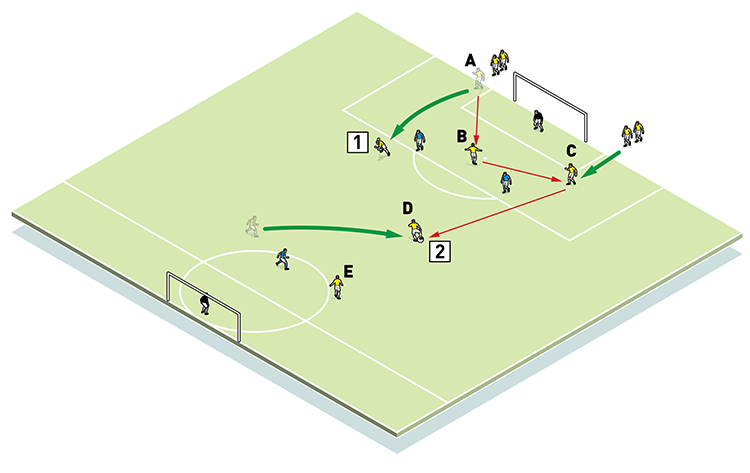
2.Player C feeds the ball in to player D, who drops deep to receive
1b
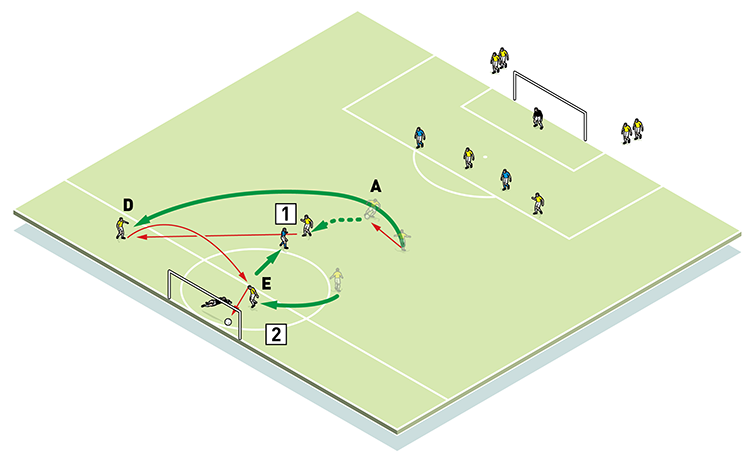
2. Player D makes a wide blindside run and finds space to receive a pass from player A, then crosses into the middle where player E heads home
2a
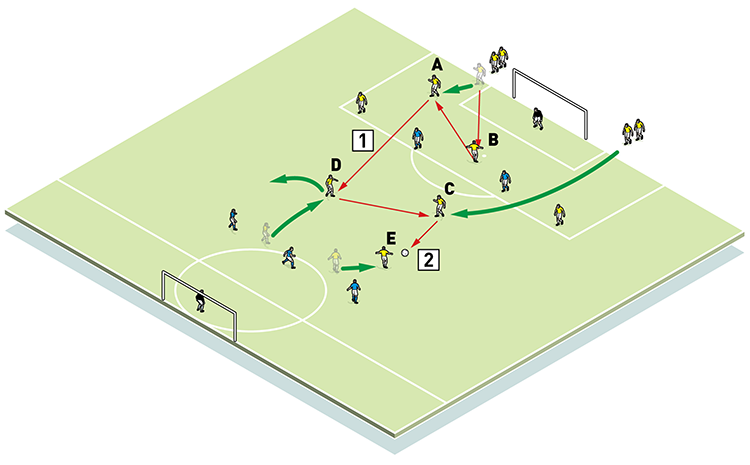
2. C makes a run from deep to receive a pass in the centre of the pitch from D. He immediately feeds a short pass to E, who, like his strike partner, drops back and approaches the ball
2b

3a
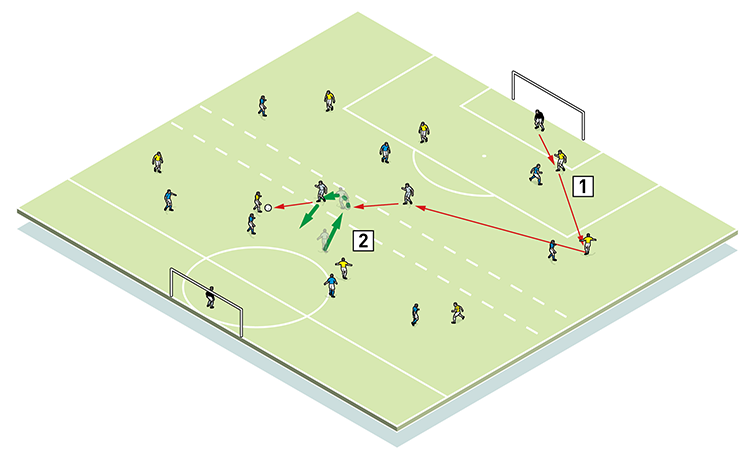
2. His fellow striker must drop back into the middle zone to receive a short pass. He then turns back into the attacking half, combining with team mates in a 5v4 overload
3b
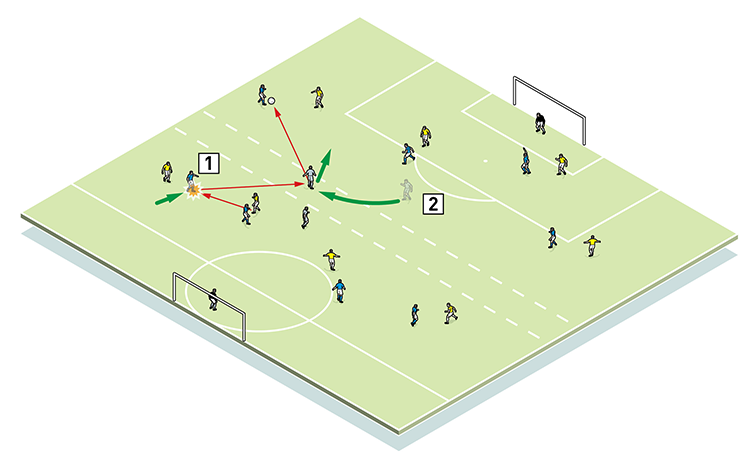
2. Again, the striker in the attacking half has to drop into the middle zone to receive the ball. Then the 5v4 attacking overload begins
In the first two moves, at the end of each attack (whether that ends in a goal, a save, a shot that goes wide or a tackle) play now comes back in the opposite direction. The third move is set up as a game and should flow as such.
Each move showcases one particular example of the type of interplay that can occur, but we will look for many different variations and passing moves, with players linking up positively and instinctively. The more variations players can practise, the more quickly and positively they will be able to combat different defensive obstacles.
How do I progress the session?
We can progress the session by adding more defenders, or by putting pressure on the forward with a time limit of 10-12 seconds to get a goal attempt in.
How do I put this into a game situation?
Once we’ve run through the three set practices, we’ll conclude with an 11v11 game on a full pitch with normal rules. Players must use the techniques learnt in the main part of the session.
Related Files
Editor's Picks
Attacking transitions
Deep runs in the final third
Using the goalkeeper in build-up play
Intensive boxes drill with goals
Penetrating the final third
Creating and finishing
My philosophy
Pressing initiation
Compact team movement
Coaches' Testimonials

Alan Pardew

Arsène Wenger

Brendan Rodgers

Carlos Carvalhal

José Mourinho

Jürgen Klopp

Pep Guardiola

Roy Hodgson

Sir Alex Ferguson

Steven Gerrard
Coaches' Testimonials

Gerald Kearney, Downtown Las Vegas Soccer Club

Paul Butler, Florida, USA

Rick Shields, Springboro, USA

Tony Green, Pierrefonds Titans, Quebec, Canada
Join the world's leading coaches and managers and discover for yourself one of the best kept secrets in coaching. No other training tool on the planet is written or read by the calibre of names you’ll find in Elite Soccer.
In a recent survey 92% of subscribers said Elite Soccer makes them more confident, 89% said it makes them a more effective coach and 91% said it makes them more inspired.
Get Monthly Inspiration
All the latest techniques and approaches
Since 2010 Elite Soccer has given subscribers exclusive insight into the training ground practices of the world’s best coaches. Published in partnership with the League Managers Association we have unparalleled access to the leading lights in the English leagues, as well as a host of international managers.
Elite Soccer exclusively features sessions written by the coaches themselves. There are no observed sessions and no sessions “in the style of”, just first-hand advice delivered direct to you from the coach.







